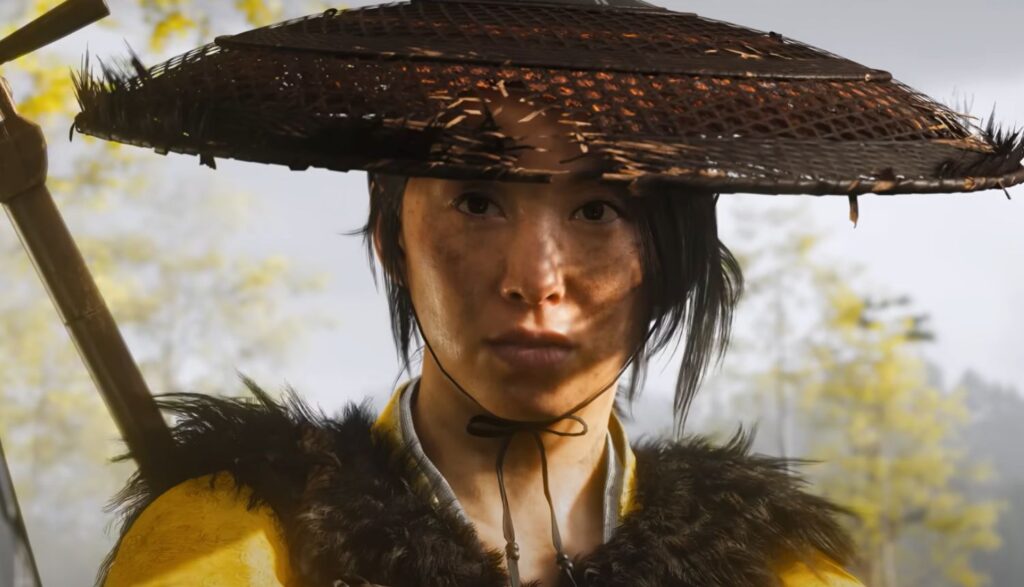
Ghost of Yōtei is the follow-up to the critically acclaimed samurai video game, Ghost of Tsushima, from 2020. But while that earlier title focused on a defeated samurai reluctantly slashing the throats of Mongol invaders in order to liberate his homeland, this newest entry isn’t as … heroic in its mindset.
Ghost of Yōtei, purely and simply, is about revenge.
The game opens in the Japanese Edo period with a group of outlaws brutally slaughtering the family of a young girl named Atsu.
Atsu stands amid the carnage and flames with her back against the trunk of a huge, burning Ginko tree, gripping a meager weapon in her hand. The head outlaw, Lord Saito, steps forward to look the quivering, blood-smeared girl in the eyes and apologize for the need to deliver a message with her death. He then slowly pushes his sword into her shoulder, pinning her to the burning tree.
However, before her demise, Atsu vows to track down every member of Saito’s Yōtei Six and bury them one by one.
As the villains ride away, Atsu rises from the ashes as a deadly onryō: A vengeful ghost of Yōtei.
Played from a third-person perspective, players crisscross the Japanese region of Ezo, improving a now older Atsu’s strengths and abilities; exploring the open world and its environmental puzzles; unlocking a diverse arsenal of melee, ranged and throwable weapons; and broadening the young woman’s list of stealth and battle attacks.
Ghost of Yōtei features a non-linear story, which allows gamers to go where they please and confront most of their Yōtei Six enemies in whatever order they think best. (However, Lord Saito is always the final boss.)
Players can take on various quests that reward them monetarily and unlock in-game abilities (such as a dual-katana attack and defense). They can follow foxes for charms and form pacts with wolves. They ride their horse across vast windblown grasslands. And when they improve their skills on an ancient stringed shamisen it allows those blowing winds to guide Atsu to new landmarks and points of interest.
Of course, the main goal of the game is to step into tense sword-swinging standoffs against solo enemies and small groups of skilled swordsmen. Players must learn about and identify various enemy archetypes and figure out which weapons and attacks will be best to counter them.
This game is designed to be played with an online connection, which provides access to various battle challenges and game content. (But it’s possible to play offline with more limited access.) And while no multiplayer option is available at this time, the game makers promise to launch a co-op mode in 2026. That free release will support two-player story missions and four-player survival matches.
Atsu’s heated quest may be all about revenge, but the game does everything it can to help players identify with her great loss. When Atsu enters certain areas, we flashback to past moments where she relives memories of her family. And Ghost of Yōtei makes it clear that Atsu is battling against a vile evil.
Atsu’s travels and her story are well-crafted and immersive. And despite the fact that she’s set on vengeance, the young protagonist is still quite likeable. Even in the midst of battle, the Japanese-styled underscore marries rhythms and traditional Japanese instruments to make the interplay into something artistic and dance-like.
This is also an incredibly beautiful game to look at. The scenic vistas often explode from the game screen like vibrant, colorful paintings of flower-strewn fields, lush forests and streams. And blending into and using those mountain ranges, windblown hillsides and colorful fauna is generally a regular part of the play.
While all of the above is true, it must be stressed that this is still a bloody game of brutal killings. Atsu can use dual katanas, a spear, a bow and an oversized ōdachi sword to hack and slash her way through crowds of attackers (especially as she grows stronger and more capable). She stabs foes in the neck, hacks off limbs and fluidly lops heads off foes. Blood and gore splatter freely.
Sometimes Atsu is called upon to stealthily clear a camp of enemies, and gamers must figure out how to leap from building tops and slip in and out of cover while slitting throats, driving blades into clavicles, dropping buckets of flaming coals and hitting distant foes with an arrow or throwing star. Atsu can also form a pact with a wolf that shows up to attack and rip out an enemy’s throat.
We see Atsu’s mother tortured and hung by the neck. People are strapped to posts and burned. Men are viciously stabbed repeatedly. Others commit suicide by slashing their own necks.
If our protagonist is beaten down and killed herself, she resurrects in a weakened and bloody form through her unexplained onryō powers.
Outside of the many, many battles involving disemboweling, face-cutting and flesh-hacking splatters that paint buildings and snow, Atsu also takes time to visit HP-reviving hot springs from time to time. There, we see her standing in the steaming water, her backside bared.
People are poisoned and drugged. We see one vomiting. And Atsu can purchase and consume sake that leaves her stumbling with blurred vision. We also hear the crudities “bulls–t” and “d–mit.”
Ghost of Yōtei has a gaming and artistic beauty about it that’s hard to ignore. But you also shouldn’t ignore the fact that this M-rated game revels in cruel torture, murdering vengeance and blood-splashing dismemberment, too.

After spending more than two decades touring, directing, writing and producing for Christian theater and radio (most recently for Adventures in Odyssey, which he still contributes to), Bob joined the Plugged In staff to help us focus more heavily on video games. He is also one of our primary movie reviewers.